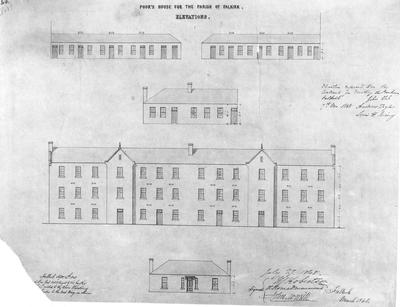Falkirk Parochial Board
Biography
The Poor Law (Scotland) Act, 1845 (8 & 9 Vict. c. 83) established parochial boards in all of the parishes of Scotland. The Act also established a Board of Supervision in Edinburgh with wide powers of control over the parochial boards. The constitution of the boards in rural areas depended on whether or not they imposed a poor rate. If they did not, they would be composed simply of the heritors and members of the kirk session; if they did they were required to add to the heritors and kirk session a varying number of members elected locally. Only a minority of parishes were legally assessed for poor rates in 1845 but the situation gradually changed and in 1862 only a minority of parishes did not impose a rate. The entitlement to relief remained unchanged and was limited to the aged and infirm. Each parochial board was compelled to appoint an inspector of the poor who was in charge of relief. Other functions were added to the parochial boards' duties including those under the Public Health (Scotland) Act, 1867 (30 & 31 Vict., c. 101) which delegated responsibilities for the regulation of lodging houses, removal of nuisances, construction of sewers, water supply and the control of infectious diseases. They were given the power to appoint medical and sanitary inspectors and to form special drainage and water districts. The public health powers were transferred to county councils by the Local Government (Scotland) Act, 1889 (52 & 53 Vict., c. 50). Special drainage districts and water districts were transferred to sub-committees of county councils. Parochial boards were replaced by parish councils in the Local Government (Scotland) Act, 1894 (60 & 61 Vict., c. 38). In 1894 Parochial Boards were replaced by elected Parish Councils, but the successor bodies frequently continued to use the same minute books and other records as their predecessors. Falkirk Poor House was opened in 1850 and accommodated poor from Falkirk and surrounding parishes. The building was replaced by Blinkbonny House in 1905, which subsequently became Windsor Hospital and was demolished in 1991. The original poor house became Woodside Home in 1905 and later was used as the County Trades School before it was demolished in the 1980s.
Share
Copy Link
Falkirk Parochial Board
Objects made by this person
Refine Results Accession number:
P25854
Name/title:
Plan of Falkirk Poorhouse
Production date:
1848, 1997
See full details
Accession number:
P25854
Name/title:
Plan of Falkirk Poorhouse
Production date:
1848, 1997
See full details
Accession number:
P25855
Name/title:
Plan of Falkirk Poorhouse
Production date:
1848, 1997
See full details
Accession number:
A9/F6
Record level:
Collection
Name/title:
Falkirk Parochial Board records
Production date:
1838-1912
See full details
Accession number:
A208.014
Record level:
Item
Name/title:
Letterhead
Production date:
28 Apr 1852
See full details
Accession number:
A1803.036
Record level:
Item
Name/title:
Falkirk Parochial Board ground
Production date:
12 Aug 1848
See full details
Accession number:
A010.057/01
Record level:
Item
Name/title:
Notice of half-yearly statutory meeting
Production date:
01 Feb 1850
See full details
Accession number:
A010.057/02
Record level:
Item
Name/title:
Notice of adjourned meeting
Production date:
06 Mar 1850
See full details
Accession number:
A010.054/03
Record level:
Item
Name/title:
Notice of half-yearly statutory meeting
Production date:
02 Feb 1852
See full details
Accession number:
A010.054/04
Record level:
Item
Name/title:
Notice of half-yearly statutory meeting
Production date:
08 Feb 1853
See full details
Accession number:
A010.054/05
Record level:
Item
Name/title:
Notice of special general meeting
Production date:
04 May 1853
See full details
Objects with this person as a subject
Refine Results
Accession number:
A208.014
Record level:
Item
Name/title:
Letterhead
Production date:
28 Apr 1852
See full details
Accession number:
A010.057/01
Record level:
Item
Name/title:
Notice of half-yearly statutory meeting
Production date:
01 Feb 1850
See full details
Accession number:
A010.057/02
Record level:
Item
Name/title:
Notice of adjourned meeting
Production date:
06 Mar 1850
See full details
Accession number:
A010.054/03
Record level:
Item
Name/title:
Notice of half-yearly statutory meeting
Production date:
02 Feb 1852
See full details
Accession number:
A010.054/04
Record level:
Item
Name/title:
Notice of half-yearly statutory meeting
Production date:
08 Feb 1853
See full details
Accession number:
A010.054/05
Record level:
Item
Name/title:
Notice of special general meeting
Production date:
04 May 1853
See full details
Accession number:
A010.054/06
Record level:
Item
Name/title:
Notice of half-yearly statutory meeting
Production date:
24 Aug 1858
See full details
Accession number:
A267.010
Record level:
Item
Name/title:
Letterhead of Falkirk Parochial Assessments
Production date:
1924
See full details
Accession number:
A847.004
Record level:
Item
Name/title:
Abstract of Accounts (Falkirk Parish)
Production date:
1930
See full details
Accession number:
A812.011/15
Record level:
Item
Name/title:
Papers on Interment fees: Falkirk Cemetery
Production date:
1874
See full details
Objects associated with this person
Refine Results
Accession number:
A812.011/194
Record level:
Item
Name/title:
Arbiters Decree in dispute, St Cuthbert's v Linlithgow Parochial Boards
Production date:
16 Apr 1846
See full details
Accession number:
A812.011/232
Record level:
Item
Name/title:
Notice of meeting of Polmont Parochial Board
Production date:
24 Jan 1848
See full details
Accession number:
A812.011/233
Record level:
Item
Name/title:
Copy memorial on ratepayer appeals
Production date:
1846
See full details
Accession number:
A812.011/247
Record level:
Item
Name/title:
Legal papers on railway liability for poor rates
Production date:
1847
See full details
